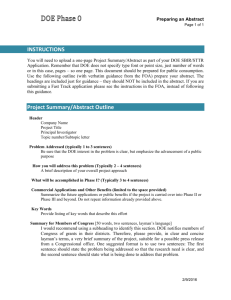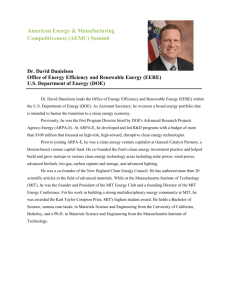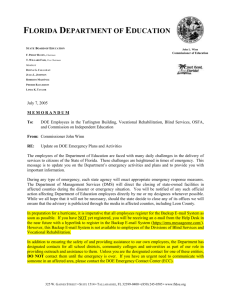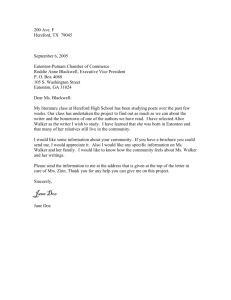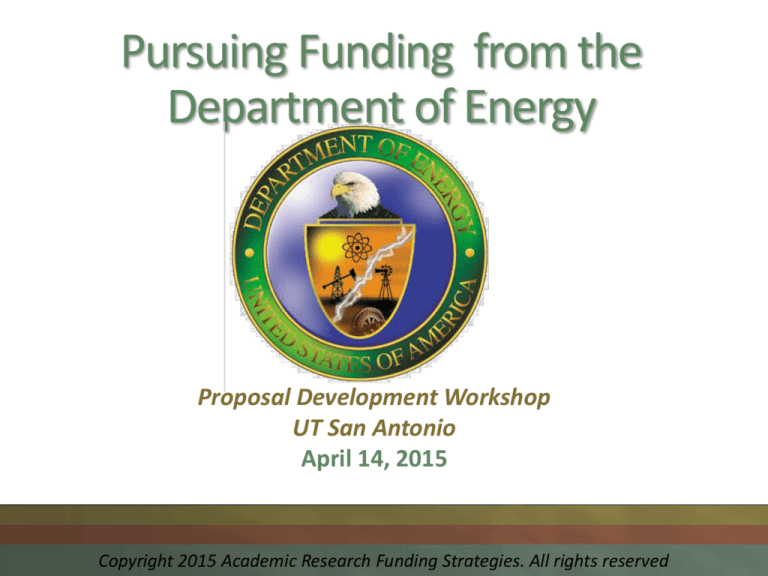
Pursuing Funding from the
Department of Energy
Proposal Development Workshop
UT San Antonio
April 14, 2015
Copyright 2015 Academic Research Funding Strategies. All rights reserved
Your CD/memory stick contains
These slides
Handouts (one pdf file)
Additional resources
Articles
These files can be downloaded from
http://1drv.ms/1awRaTL
Academic Research Funding Strategies, LLC
Our goal:
To help your institution, faculty and staff to
develop the skills they need to compete
successfully for research funding.
http://academicresearchgrants.com
3
Lucy Deckard
Ldeckard@academicresearchgrants.com
979-693-0825
Founder and President, Academic Research Funding
Strategies, LLC (2010)
Nine years in research and proposal development at Texas
A&M University as associate director of two research
development and grant writing offices
BS/MS Materials Science and Engineering
Junior Faculty Initiative, CAREER, instrumentation, research,
education, Center-level proposals
NSF, NIH, DOE, DoD, DoED, IMLS, Foundations
Research Engineer (16 years in applied research, with
extensive proposal writing experience to NSF, DARPA, ONR,
AFOSR, ARO, DOE)
4
Examples of Education Funders
U.S. Department of Education (ED)
National Science Foundation
Institute of Education Sciences (ED/IES)
National Center for Education Research (IES/NCER)
Texas Education Agency
National Science Foundation
William T. Grant Foundation
Spencer Foundation
Arthur Vining Davis Foundations
Russell Sage Foundation
Alfred P. Sloan Foundation
Ford Foundation
Foundations for Education Excellence (Foundation Center)
More
5
Grant Rule #1:
Get to Know Your Potential Funder!
6
Mission agencies are different
from basic research agencies!
7
Basic vs. Mission Agencies
Basic research agencies (NSF, NIH)
Relatively stable research agendas
Broad goals
Agenda relatively unaffected by changes in political
leadership
Mission agencies (DOE, DoD, ED, NASA, NOAA,
EPA, HUD, NIST, etc.)
Focused mission set by Congress
Agendas can change quickly
Strongly affected by changes in political leadership
Typically strong intramural research
8
Intramural vs. Extramural Research
Some agencies fund only research by outside
scientists - extramural research
NSF and DARPA
Some agencies fund research by internal
scientists – intramural research
NIST and the National Labs
Many fund both intramural and extramural
research
E.g., NIH, DOE, DoD, USDA, etc.
If Intramural Research in Your Area
Often a good idea to develop relationships
and collaborate with internal scientists
Some agencies encourage faculty to
participate as visiting researchers during
the summer
Pursuing Funding at Mission Agencies
Step 1: Get to know your agency!
Learn the language
What are their current priorities?
How do they announce funding opportunities?
Do they fund unsolicited proposals and what proportion of
funded grants are unsolicited?
Are there particular organizations within the agency that
fund research?
Do they have a strong intramural research program in your
area?
Who reviews proposals?
Who is the Program Officer overseeing extramural research
in your area?
11
Pursuing Funding at Mission Agencies
Step 2: Get to know your Program Officer
Talk to her on the phone
Visit him at his offices
Look for her at conferences
Find out what problems and issues the P.O. is tasked
with addressing
Talk about how your research might help the agency
address those issues
If your research doesn’t fit, look to another program
or agency
12
Pursuing Funding at Mission Agencies
Step 3: Get to know intramural researchers in
your area (if applicable)
What do they see as important issues?
Can you collaborate?
Do they host academic researchers in their labs in
the summer?
Do they host students for internships?
13
Pursuing Funding at Mission Agencies
Step 4: Understand the proposal process at the
agency
Do they fund unsolicited proposals?
Do you need to submit a white (concept) paper or
pre-proposal first?
What are the proposal structure and format
requirements?
What are the review criteria?
14
General strategies for DOE
Find and define your research home at DOE
Map your research to that domain
Learn the DOE grant cycles/BAAs
Understand the DOE mission, culture, and research priorities by
office and program
Understand the DOE review process at all scales
Talk to DOE program officers
Talk to colleagues funded by DOE
Subscribe to DOE RSS frees and email alerts
View DOE webinars
Review DOE strategic plan and other documents at agency level,
office level, program level, etc.
15
DOE Research Organizations
Office of Science
Culture similar to NSF and NIH
Includes National Labs (intramural research)
ARPA-E
ARPA-E is modeled after the successful Defense Advanced Research
Projects Agency (DARPA).
ARPA-E Solicitations
National Engineering Technology Laboratory
Part of Office of Fossil Energy
NETL Solicitations
Energy Efficiency and Renewable Energy (EERE)
EERE Solicitations
Unsolicited proposals to EERE
Office of Nuclear Energy
University Program Solicitations
DOE Org Chart
Example DOE Entry Points
Office of Energy Efficiency and Renewable Energy
Works with business, industry, universities, and others to
increase the use of renewable energy and energy efficiency
technologies.
Golden Field Office
Part of EERE
Oversees National Renewable Energy Lab
Office of Fossil Energy
Most R&D procurements coordinated by NETL.
Participates in DOE's Small Business Innovation Research
(SBIR) and Small Business Technology Transfer (STTR)
programs.
Office of Nuclear Energy, Science and Technology
Promotes nuclear power
University Program Solicitations
17
Example DOE Entry Points (cont’d)
Office of Science
Grants etc coordinated through SC Office of Grants
and Contracts Support (GCS
ARPA-E
Answers to Secretary of Energy
ARPA-E Solicitations.
18
Role of the National Labs
DOE Office of Science’s intramural research arm
Many funded projects involve collaborations
with the NLs
NL researchers in your area are likely to be
reviewers of your proposal
Get to know NL researchers in your area!
Consider pursuing a summer research
position at the Lab
Consider sending your students for
internships a the Lab
19
Office of Science
Supports fundamental scientific research for
energy
Nation’s largest supporter of basic research in the
physical sciences (includes intramural funding)
Organized into eight program offices
Each office issues its own solicitations, has its own
culture and organization
Solicitations called Funding Opportunity
Announcements (FOAs)
Financial Opportunities
FY 2015 Continuing FOA
2
0
Office of Science focuses on:
The frontiers of science – subatomic particles,
atoms, and molecules
The 21st Century tools of science – providing
over 30 national scientific user facilities
Science for energy and the environment –
advancing clean energy through
3 DOE Bioenergy Research Centers (BRCs)
Energy Frontier Research Centers (EFRCs)
2 Energy Innovation Hubs
Office of Science Program Offices
Advanced Scientific Computing Research
Biological & Environmental Research (BER)
Basic Energy Sciences (BES)
Fusion Energy Sciences (FES)
High Energy Physics (HEP)
Nuclear Physics (NP)
Also
Workforce Development for Teachers & Scientists
Small Business Innovation Research (SBIR) and Small Business
Technology Transfer (STTR)
2
2
Understand Grand Challenges in
Your Field as Identified by DOE
Grand challenges reports
Example for ASCR
Grand challenges workshops
Example for ASCR
These articulate DOE’s interests
Keep up with the news for your program: example
Responding to Office of Science
Continuing FOA
Current FY 2015 FOA in effect until Sept. 30,
2015
Find program and program officer
Prepare pre-application (up to 3 pages) – optional
but strongly recommended
Program officer will provide feedback
If encouraged, submit full proposal
No specific due date
Typically 200 – 350 new awards each year
24
Example: Basic Energy Science
BES supports fundamental research to understand, predict, and
ultimately control matter and energy at the electronic, atomic,
and molecular levels in order to provide the foundations for new
energy technologies and to support DOE missions in energy,
environment, and national security
BES also plans, constructs, and operates major scientific user
facilities to serve researchers from universities, national
laboratories, and private institutions.
BES research provides a knowledge base to help understand,
predict, and ultimately control the natural world and serves as an
agent of change in achieving the vision of a secure and
sustainable energy future.
2
5
Example: Basic Energy Sciences
2
6
2
7
BES Funding Opportunities
Funding Opportunities listed here
Core research activities (CRAs) listed here
BES Staff directory listed here
Can respond to continuing FY FOA
Contact the BES program manager in your area
If program manager likes your idea, submit a
preapplication (2 – 3 pages)
If they like that, you’ll be encouraged to submit a full
application
No due date
Also specific FOAs with due dates and procedures
Also fund Early Career Research Program, DOE Office
of Science Graduate Fellowship
2
8
Pre-application
Up to 3 pages
Summary of proposed resarch
List of proposed collaborators/coinvestigators/consultants
Brief bio information fo PI
ROM cost estimate
Submit through PAMS (Portfolio Analysis and
Management System)
Must choose subprogram
3
0
DOE Early Career Research Program
Early Career Research Program Page
Last year’s FOA
Min. $750K over 5 years
Untenured, no more than 10 years past PhD
Preapplications last due Sept. 2014
Full proposals last due Nov. 2014
Abstracts of last year’s awards here
Be careful – funding rates extremely low!
Approx. 21 awards to non-NL researchers last year
3
2
Typical DOE Gates
Quad Charts
Concept Paper
Full Proposal
Quad Chart Example
(Format varies by agency and program)
Project Title
3
4
TOP LEFT QUADRANT
The Objectives
TOP Right QUADRANT
Illustration
WHAT you will do using bullet format.
A representative illustration
BOTTOM LEFT QUADRANT
Approach
BOTTOM RIGHT QUADRANT
Key Milestones and Cost
How the task will be accomplished
using bullet format. This quadrant also
lists any Co-Pis/Partners
When the key milestones of the project
will be accomplished
How much it will cost
EERE
3
6
So what is a white paper?
Also called a “concept paper”
Provides critical info to help P.O.
determine fit for agency and program
Usually very brief
P.O. provides guidance
How are Concept Papers Evaluated?
Evaluation Criteria specific to a given Funding
Opportunity Announcement (FOA)
May vary by FOA.
Applicants should always refer to the FOA to
which they are applying for the relevant
evaluation criteria.
ARPA-E may also use Program Policy Factors
Based on agency needs and priorities
Understand role of concept papers
Avoid unwarranted effort on proposals not of
interest to the agency
Must distill your research vision, goals, and
objectives into a succinct and clear description
PO must be able to quickly grasp :
Significance of your project
how the research will advance the research
mission of the agency
3
9
Common Concept Paper Mistakes
Does not clearly state the relevance to agency mission
No compelling case for the value of the research to the
agency
Lack of understanding of the agency mission
Emphasizes technical minutiae and detail over the
mission significance and impact of the research
Poorly organized, poorly written, grammar errors,
spelling errors, too ambiguous, poorly argued
Uses too much jargon
41
Planning Your Project
Start with your great idea
Translate it into a project
What will your outputs be?
How long will it take?
What will your approach be?
What have you done so far?
How will the outcomes advance DoD program
goals and DoD mission?
42
Define Your Project Story
The Need/Motivation
Goals
Gaps in Knowledge/Capabilities
New Knowledge/Capabilities
Hypotheses/Research Questions
Innovations
Approach
Objectives
How it’s Different
Significance
Outcomes
How they support DoD mission
43
Put Your Project in Context
Preliminary Work Funded project 1
Further work
Project Goals/Specific Aims
Outcomes
The Big Question or
The Big Need
Cut to the Chase!
Reviewer’s Attention Level
14
12
Get to the
exciting
Concise background
stuff here! Strong,
that provides context
Unique Intro
10
8
Generic Intro
6
4
2
Long, scholarly
background
0
First
Paragraph
Zzzzzzz
Get to the
exciting stuff
here!
Heilmeier Catechism
Have a clear structure
For example…
Project Goals
Objectives
Research
Questions/Hypotheses
Phases
Tasks
Subtasks
Schedule and Milestones
What do you expect to have accomplished
after 6 months? After 1 year? After 18
months? Etc.
Provides easy-to-find synopsis of your
approach for reviewers
Demonstrates that your project is properly
scoped
Shows that your project is well thought out
Example Flow Charts and Schedules
Year 1
Objective 1: Development of the hoosits
Integration and calibration
Optimization of frumpits measurement methodology
Objective 2: Assess XYZ
XYZ spectroscopy
MOA microscopy
ABC testing
Pandax studies
Objective 3: Integrate hoosits with XYZ
Instrument integration
Instrument testing
Demonstration
Year 2
Year 3
Year 4
Year 5
ARPA-E’s 5 deadly sins
Insignificant
Indistinguishable
Incremental
Incoherent
Indefinite
See more here.
ARPA-E’s Best Practices for Full Proposals
Describe the technological innovation in the first
sentence
Provide a visual aid describing technology directly after
the first paragraph
Back up claims with data or strong scientific rationale
Compare proposed technology to the state of the art
Clearly identify the technical challenges and
approaches to solving them
Go here for examples
Questions?


